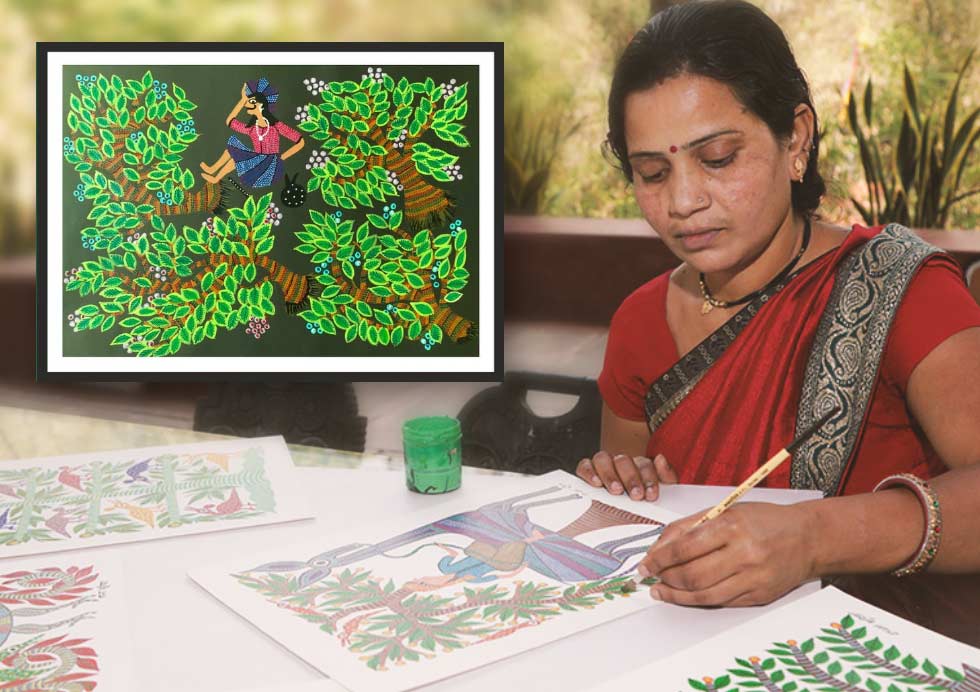Bhil Art is a colorful and expressive folk art form that originated in central India. Bhil painting, a tribal folk art type prevalent in many regions of Central India, is best renowned for its depiction of Hindu gods, goddesses, animals, and other natural landscapes. This art was traditionally created on mud walls and floors using rice paste and natural pigments. It is now also painted on canvas and paper. Bhil art is a unique reflection of the tribe’s culture, history, and beliefs.
Bhil Tribe And Their Love For Nature
The Bhil tribe has a deep-rooted connection with nature and their surroundings. Bhil paintings reflect their close relationship with the natural world, their animistic beliefs, and their reverence for deities and spirits. The art form serves as a medium for storytelling, expressing religious beliefs, and capturing the essence of their daily lives.
Mythology plays a significant role in Bhil’s paintings. The Bhil tribe has its own set of myths and folklore, passed down through generations orally. These tales often revolve around deities, heroes, and legendary figures. The paintings depict these mythical characters and their exploits, representing stories of creation, battles between good and evil, and the triumph of the righteous.
Culture and Rituals Are Also Prominent Themes in Bhil’s Paintings
The Bhil art form portrays the customs, traditions, and rituals observed by the Bhil tribe. Bhil paintings serve as visual narratives, portraying ceremonies, festivals, and significant life milestones like birth, marriage, and death within the Bhil culture. Symbolic elements are thoughtfully incorporated to convey concepts of auspiciousness, fertility, protection, and other integral aspects of their rich cultural heritage.
Bhil paintings are characterized by their vibrant colors, bold lines, and intricate detailing. The artists use natural pigments derived from minerals, plants, and even cow dung. These colors add vibrancy to the artwork and reflect the harmony between the Bhil community and nature.
Bhil paintings, originally crafted on diverse surfaces like walls, floors, and mud huts, have evolved over time. Today, they find expression in mediums such as paper, cloth, and canvas, both to reach a wider audience and to ensure the preservation of these invaluable artworks.
Bhil paintings not only serve as a visual representation of the Bhil community’s cultural heritage but also provide an economic livelihood for the artists. The art form has gained recognition beyond the local communities, attracting art enthusiasts, collectors, and scholars who appreciate its unique aesthetic and cultural significance.
In recent years, efforts have been made to promote and preserve Bhil paintings. Various organizations, government initiatives, and NGOs have worked to provide training, marketing platforms, and financial support to Bhil artists. This support has helped sustain the art form, empower the community, and create opportunities for economic growth.
Bhil paintings are still a popular art style today, preserving the Bhil tribe’s rich mythology, cultural customs, and spiritual beliefs. They are a monument to this indigenous population in India’s lasting inventiveness, perseverance, and cultural history.
Bhil Paintings and Bhuri Bai
Over time, Bhil artists have also adapted their traditional art form to other mediums like paper and canvas. One prominent Bhil artist known for her contributions to the art form is Bhuri Bai. Bhuri Bai, also known as Bhuri Bai Barot, is a renowned Bhil artist from the Jhabua district of Madhya Pradesh, India. She was born in 1945 and has played a significant role in popularizing Bhil art globally.
Bhuri Bai’s paintings reflect the rich cultural heritage and mythological beliefs of the Bhil community. Her works often depict tribal gods and goddesses, folk stories, and the daily life of the Bhil people. She uses bold and vibrant colors, intricate patterns, and a unique style that sets her artwork apart.
Her talent and dedication to preserving and promoting Bhil art have earned her international recognition. Bhuri Bai’s Bhil paintings have been exhibited in various art galleries and museums around the world, including India, the United States, and Europe. Bhuri Bai’s contributions have also helped in empowering and providing economic opportunities to the Bhil community through the sale of their artwork.



